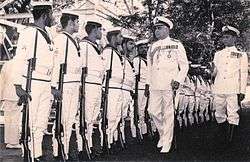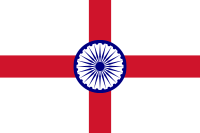Sardarilal Mathradas Nanda
| Admiral Sardarilal Mathradas Nanda PVSM, AVSM | |
|---|---|
|
Admiral Nanda reviewing an honour guard at INS Adyar in 1972 | |
| Born |
10 October 1915 Punjab, British India |
| Died |
11 May 2009 (aged 93) New Delhi, India |
| Allegiance |
|
| Service/branch |
|
| Years of service | 1941–1973 |
| Rank |
|
| Commands held | |
| Battles/wars | |
| Awards |
Padma Vibhushan Param Vishisht Seva Medal Ati Vishisht Seva Medal |
| Other work |
Author, "The Man Who Bombed Karachi" Member of the Board of Directors, Crown Corporation |
Admiral Sardarilal Mathradas Nanda, PVSM, AVSM (10 October 1915 – 11 May 2009) was a Four-Star Admiral of the Indian Navy who served as the 8th Chief of the Naval Staff from 1 March 1970 until 28 February 1973.[1] He led the Indian Navy during the Indo-Pakistani War of 1971 and successfully executed a naval blockade of both West and East Pakistan, helping India achieve an overwhelming victory during the war.[2] He is one of the most notable commanders in the history of the Indian Navy.
Early life
Nanda was born on October 10, 1915 in Punjab. He was raised on Manora Island at the entrance to the Port of Karachi.[1][3] He was the eldest of seven children. Prior to joining the navy, Nanda had worked for the Karachi Port Trust.
Naval career
Nanda enlisted into the Royal Indian Navy Volunteer Reserve during World War II on 11 October 1941. He stayed in the Navy despite rapid, large-scale demobilization at the end of the war. After independence in 1947, he opted to join the Indian Navy. In 1948, he was appointed First Lieutenant on board INS Delhi (1948) under the command of Captain H.N.S Brown, with then Lieutenant Commander Ram Dass Katari as his Executive Officer.[1]
From 1949 to 1951, he served as the Director of Personnel Services. In 1951, he took command of the R class destroyer, INS Ranjit (1942). He was also the commanding officer of the navy's Frigate Squadron. He was later transferred back to Naval Headquarters as Chief of Personnel. He was promoted to Commodore in 1957, and sent to England to commission the Fiji class cruiser, INS Mysore (1957), as her Commanding Officer. Later, he was appointed Director General of the Naval Dockyards and undertook a major expansion of the dockyards. He then attended the Imperial Defence College and was appointed Chief of Materials upon his return. Nanda was promoted to Rear Admiral and appointed Deputy Chief of Naval Staff in May 1962. He was appointed Managing Director of Mazagon Dock Limited in December 1964 and undertook preparations for the construction of Nilgiri class frigates, the first major naval vessels to be constructed in India. Given the difficulty India had in negotiating the purchase of INS Vikrant (R11) from the UK, Nanda supported the acquisition of equipment from the Soviet Union.
The 1962 Sino-Indian War was largely fought over the Himalayas and the Navy did not have a major role. During the Indo-Pakistani War of 1965, the Navy was ordered to stay within Indian waters. When the Pakistani Navy bombarded Dwarka, Nanda recognized the need to raise the Navy's profile and capabilities.
Chief of Naval Staff
In March 1970, Admiral Nanda took command as the 8th Chief of the Naval Staff of the Indian Navy. He was determined to change the mindset of the service from defence to attack. He got the opportunity to demonstrate this capability the following year during the war with Pakistan. Nanda was instrumental in framing India's Naval strategy during the war. He feigned a defensive deployment southeast towards the Andaman Islands, instead moving his Eastern fleet northwards into the Bay of Bengal and enforcing a naval blockade against East Pakistan.
His strategy against West Pakistan was to strike hard against Pakistan's main port of Karachi.[1] He is recognized as the mastermind behind Operation Trident and Operation Python.[4] The plan for the operations included towing the limited-range Vidyut class missile boats, primarily designed for coastal defence, to about 250 nautical miles (460 km) south of Karachi during the day, out of range of the Pakistan Air Force aircraft.[5] The missile boats then closed in on Karachi port at night and attacked naval targets as well as the oil tank farm at Keamari. Operation Trident was successfully executed on 4 December 1971, sinking the Pakistani Navy destroyer PNS Khaibar, minesweeper PNS Muhafiz, an ammunition carrying ship MV Venus Challenger and irreparably damaging another destroyer PNS Shah Jahan as well as destroying numerous oil storage tanks. Operation Python was again successfully carried out on 8 December 1971.
On the Eastern front, Nanda made the decision to deploy the aircraft carrier INS Vikrant into the shallower waters of the Gulf of Bengal off Dhaka, to prevent the risk of a submarine attack. When concerns were raised about Vikrant's boilers being cracked, he took personal responsibility for the risk of a boiler explosion and catapult failure on the carrier. His gambit paid off, as Vikrant was able to successfully enforce the blockade of East Pakistan without any such damage to the carrier. The success of the naval blockades on two fronts is considered one of the primary factors in India's overwhelming victory during the war. Admiral Nanda retired from the Indian Navy in 1973.
Awards
Admiral Nanda was revered in the Indian Navy for his bold decision-making and for frequently defeating bureaucracy in his quest to improve the living conditions of his sailors and their families. For his heroism at sea, he was at times called India's Nelson.
He was awarded the Ati Vishisht Seva Medal in 1961 and the Param Vishisht Seva Medal in 1966. He was awarded the Padma Vibhushan in 1972.[1][6]
Later life
Following his retirement, Nanda took an executive role with Crown Corporation, an arms trading firm headed by his son Suresh Nanda, which specialized in supply of imported weapons to the Indian Armed Forces.[7]
Nanda's reputation was tarnished by the involvement of his family in several high-profile controversies, two of which involved allegations of corruption and payment of bribes to Indian government officials for facilitating arms sales. A third case was an attempt at a cover-up by his son and grandson in a hit-and-run drunk driving accident, in which three policemen and three other individuals were killed at a police checkpoint by a speeding BMW driven by his grandson Sanjeev Nanda.
Controversies
- Operation West End was a sting-operation which exposed corruption between India's defence ministry and Crown Corporation. Admiral Nanda's son, Suresh Nanda, is alleged to have paid bribes to defence minister George Fernandes and other Samata Party officials for:
- Selecting the Barak SAM system by Israel Aircraft Industries over the objections of the Indian defence research organization head APJ Abdul Kalam.[8]
- Selecting the Slovakian Armoured Recovery Vehicles by disallowing a lower-priced Czech quotation.[9]
- The BMW hit-and-run case, involved Admiral Nanda's grandson and Suresh Nanda's son, Sanjeev Nanda, was charged with driving over 6 people including 3 policemen around 3 AM on 10 January 1999 in a drunken state, in a BMW car at high speed. The car did not stop, but the trail it left in its wake could be followed in the morning to where it was being cleaned of blood and other human remains.[10] As of 2007, the case was in appeal in a higher court after Sanjeev Nanda was acquitted in a lower court after allegations of bribery of the sole-surviving witness, who changed his testimony in court to say that he was no longer sure what hit them, and that it could have been a truck.
- He used all his contacts in the government and navy to push the business of his son.
Death
Admiral Nanda died in New Delhi on 11 May 2009 at the age of 93. His funeral was marked with full military honours,[11] but not as well attended as his naval career mandated due to the involvement of his family in controversial cases.[1]
References
- 1 2 3 4 5 6 "Naval Obituaries: Admiral Sardarilal Nanda". The Telegraph. 2009-06-16. Retrieved 2011-07-20.
- ↑ "The man who bombed Karachi". Indian Express. Retrieved 2007-02-07.
- ↑ "Karachi burned for seven days". Rediff. 2007-01-18.
- ↑ "Former Naval chief S M Nanda dies". The Times of India. 2009-05-13. Retrieved 2011-11-22.
- ↑ "Indian Navy's War Hero passes away: Cmde Babru Yadav led the Missile Boat Attack on Karachi in 1971". India Strategic. April 2010. Retrieved 2011-07-21.
- ↑ http://india.gov.in/myindia/padmavibhushan_awards_list1.php
- ↑ "'The man who bombed Karachi' dead". The Telegraph India. 2009-05-13. Retrieved 2011-07-21.
- ↑ V. Venkatesan (2006-11-03). "Dubious deal". Frontline (magazine). Retrieved 2007-06-16.
- ↑ "Tehelka Tapes (transcript)". Tehelka.com. p. 21. Archived from the original on 2006-07-20. Retrieved 2006-08-17.
- ↑ "Charged with culpable homicide". Indian Express. 1999-04-08. Retrieved 2007-07-16.
- ↑ "Former Naval chief Admiral S M Nanda passes away". Times of India. 2009-05-12. Retrieved 2011-07-21.
| Military offices | ||
|---|---|---|
| Preceded by Adhar Kumar Chatterji |
Chief of the Naval Staff 1970–1973 |
Succeeded by Sourendra Nath Kohli |

